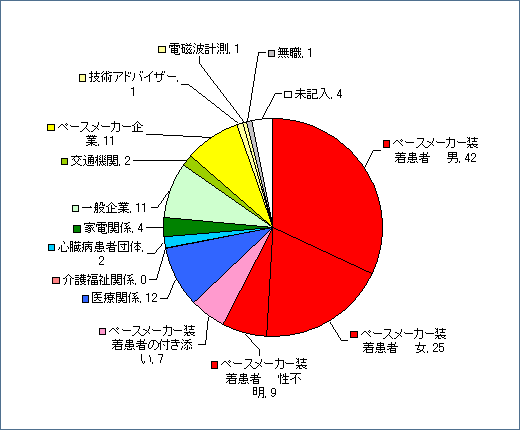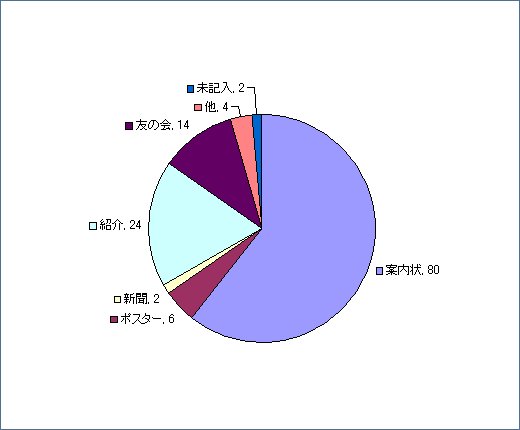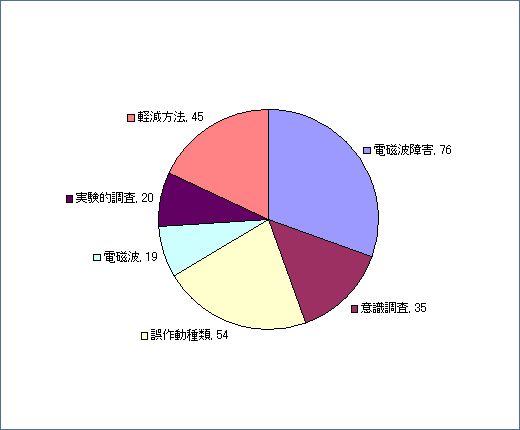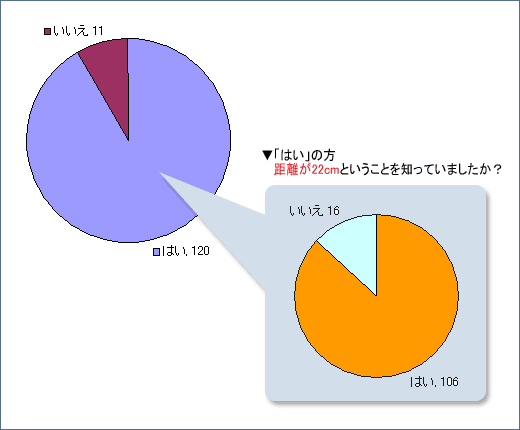Research and Development Menu (Tap to display menu)
Public Citizen Lecture, Osaka Medical University, Japan
February 7, 2004: Public Symposium on Electromagnetic Interference with Cardiac Pacemakers
●February 7, 2004 – Survey Results 1: Public Symposium on Electromagnetic Interference with Cardiac Pacemakers
■ Questions (Click to view results)
- Breakdown of survey respondents
- 01. How did you learn about the symposium?
- 02. Which theme did you find most interesting?
- 03. Were you aware that electromagnetic waves can affect pacemakers?
- 04. Did you know about the safe distance from mobile phones?
- 05. What would you like to ask the research group in the future? What would you like them to do?
- 06. Other comments or feedback
Breakdown of survey respondents
(Unit: People)

Question 1: How did you learn about the symposium?
(Unit: People)

Question 2: Which topic did you find most interesting?
(Unit: People)

Question 3: Were you aware that electromagnetic waves can affect pacemakers?
(Unit: People)

Question 4: Did you know there is a safe distance from mobile phones?
(Unit: People)

● February 7, 2004 – Survey Results 2: Public Symposium on Electromagnetic Interference with Cardiac Pacemakers
Question 5: What would you like to ask the research group in the future? What would you like them to do?
■ General Public / Pacemaker Patients
- 01. Whether linear motor cars pose any risk to pacemakers as a mode of transportation.
- 02. Comparative data on electromagnetic interference by pacemaker model.
- 03. I work in environments with high electromagnetic fields. Please teach shielding methods.
- 04. Development process and outlook for specific electromagnetic wave mitigation technologies.
- 05. As ICDs have been developed, please consider developing pacemakers that can stop atrial fibrillation attacks.
- 06. I hope patient awareness surveys will continue in the future, and that the results will be shared.
- 07. Please introduce sellers of shielding materials and shielding garments.
- 08. I'm troubled by the poor manners and phone usage on crowded public transport. Please urge railway companies to take stronger action beyond simple announcements—for example, separate cars with no-phone zones and stickers. I hope medical professionals will make suggestions as well.
- 09. Effects and countermeasures of MRI, etc. (already asked)
- 10. I hope such symposiums are held at universities in other regions as well.
- 11. I can't say specifically what I want to ask, as I'm not an expert, but I hope the research group continues patient-centered studies and pacemaker advancements.
- 12. Guidance for automatic mahjong table manufacturers (considering the growing interest in mahjong among elderly people).
- 13. Please explain the scientific theory of pacemakers in a way that's easier to understand.
- 14. I’d like to know more about cases where both a pacemaker and ICD are implanted in the same person.
- 15. I always hope that electromagnetic interference can be minimized.
- 16. About electromagnetic fields from devices used in beauty salons and esthetic clinics; also, precautions for pacemaker patients with other conditions like asthma.
- 17. As a pacemaker user, I’d appreciate easier-to-understand explanations of the device.
- 18. I'm very anxious about future developments in electromagnetic and magnetic fields. I’d like to learn more about electronic devices in daily life.
- 19. Please develop a combined device that integrates both PM and ICD functions.
- 20. I wanted to hear firsthand stories from pacemaker patients.
- 21. I hope pacemakers will incorporate ICD functions.
- 22. I want to stay informed with new information and live each day with proper understanding.
- 23. I was very anxious about the relationship between pacemakers and electromagnetic waves, but attending today’s symposium clarified things. I live alone and often feel anxious. I plan to purchase a mobile phone soon. I appreciate such relatable symposium topics and hope for more.
- 24. Please develop pacemakers that are resistant to electromagnetic interference.
- 25. It was unclear what Dr. Tanaka and Dr. Matsumoto were trying to say—please avoid overlapping content.
- 26. People #4 and #5 didn’t seem to understand the time constraints well. We didn’t understand them either.
■ Companions of Pacemaker Patients
- 01. Our attending physician is too busy to explain much, so I’ve learned a lot for the first time by attending this seminar. I want to study hard for my husband. When I actually study, I realize that the doctor’s explanation is only about 10% of what I need—more explanation would be appreciated.
- 02. The speaker’s voice was muffled due to microphone issues, making it hard to hear. Please focus on improving patients' quality of life and happiness.
■ Medical Professionals
- 01. I hope for presentations that are truly helpful for actual pacemaker patients. This research seems difficult, and there’s a risk it may become self-satisfying for the researchers without being understandable to patients.
- 02. Whether natural phenomena-based electromagnetic waves affect pacemakers (PM).
- 03. If there were tests on the effects of industrial machinery, such as welders or motors, I might be able to return to my previous job.
- 04. Accurate information supported by scientific evidence.
- 05. I hope pacemaker devices themselves can be made immune to electromagnetic interference.
- 06. As Dr. Takeuchi mentioned during the session, please also provide education for non-specialist healthcare workers—not only doctors but also nurses, clinical laboratory technicians, and other co-medical staff who frequently interact with medical electronic devices like pacemakers and ICDs.
■ General Companies
- 01. Effects of electromagnetic waves not only on pacemakers but on the human body in general.
- 02. Trends in the development of shielding materials.
- 03. Establish methods to mitigate effects and disseminate the information to relevant industries and users.
- 04. Opinions from patients and their daily lifestyles.
■ Pacemaker Manufacturers
- 01. I’d like to hear countermeasures and opinions from consumer electronics manufacturers and companies responsible for sources of electromagnetic interference.
- 02. How about holding symposiums nationwide?
■ Other
- 01. I speak with other parents whose children have pacemakers. How much research is being done on children? If possible, please include data focused on pediatric cases.
- 02. About pacemakers for children.
- 03. Are quantitative details such as radio wave strength and modulation methods published on the website or elsewhere?
- 04. I’d like more public awareness raised about the effects of magnetic fields.
● February 7, 2004 – Survey Results 3: Public Symposium on Electromagnetic Interference with Cardiac Pacemakers
Question 6: Other Comments and Feedback
■ General Pacemaker Patients
- 01. It was very informative. Thank you very much.
- 02. I could not understand the fifth speaker at all.
- 03. The moderator of the keynote speech should be more concise. Stick to the scheduled time. It’s important not to rush at the end.
- 04. I believe many people have pacemakers implanted without understanding what they are. To reduce anxiety, joining the "Japan Pacemaker Friends Association" will provide useful information. Please encourage patients to join.
- 05. Reports from manufacturers responsible for noise (interference).
- 06. Dr. Okamoto’s talk on "What is Electromagnetic Radiation?" was too technical and difficult for me to understand.
- 07. This event was very educational. Thank you. I sincerely hope it continues in the future.
- 08. Please make the talks easier to understand for the general public.
- 09. I received explanations on whether specific devices are affected by electromagnetic waves, which was very helpful. However, due to my lack of basic knowledge, some parts of the symposium were difficult to understand—perhaps it was too specialized?
- 10. Many elderly attendees have hearing difficulties, so please speak slowly and loudly.
- 11. As this was my first experience, it was extremely helpful. Thank you very much.
- 12. The research should not be limited to a university setting but should involve many medical professionals and patients. I’ve had a pacemaker for 18 years without replacement. The model is VV1 (due to sinoatrial node issues). I didn’t receive much explanation from the doctor; I was simply told it needed to be implanted immediately. Since then, I’ve experienced various issues and felt depressed. However, due to my job, I still use various tools (related to electromagnetic waves), sometimes even close to my chest. Today’s talks were very informative. Although technology keeps advancing, there is still no device to protect pacemakers from EM interference, so I constantly remind myself: "Don’t approach it, don’t touch it, don’t overlook it."
- 13. Parts 3 and 5 of the symposium were too technical to understand.
- 14. I understood most of it, but some parts were quite difficult.
- 15. It was a bit tiring time-wise.
- 16. Presenters should use cordless microphones. It made the audio clearer (Prof. Matsumoto).
- 17. Some speakers, particularly non-doctors like Mr. Tanaka and Mr. Okamoto, were difficult to hear and understand due to poor microphone use and speaking skills.
- 18. The second half was hard to hear.
- 19. Please continue your research and investigations going forward.
- 20. The topic "What are electromagnetic waves?" was somewhat difficult for patients.
- 21. I learned a lot. The microphone improved partway through (it was hard to hear at first).
- 22. Some parts of the explanation were hard to hear, and there were technical topics I couldn’t understand. Thank you for the learning opportunity.
- 23. The content was quite advanced and difficult to grasp without medical knowledge. Some speakers were not very good at presenting.
- 24. I learned a great deal. Thank you very much.
- 25. Surrounded by many fellow pacemaker users and hearing various opinions, it was a meaningful experience. Thank you.
- 26. The speakers understood the topics, but for laypeople, it was hard to hear and understand.
- 27. This was my first time attending, and I learned a lot. I’d like to attend again.
- 28. I hope trains and buses will have cars that block electromagnetic waves. Kansai is too lenient on this issue.
- 29. It was hard to understand.
- 30. Please allow more time for questions.
■ Companions of Pacemaker Patients
- 01. Please provide information to help improve patients’ quality of life. We hope for a system that allows continuous consultation for emerging concerns.
- 02. Topics 4 and 5 of the symposium were poorly presented. The speakers’ endings were hard to understand.
■ Medical Professionals
- 01. Some presenters were hard to understand. When they got to a critical point, they mumbled... so I couldn’t follow. That was disappointing.
- 02. The idea of developing something that blocks electromagnetic waves from affecting pacemakers was a new insight from patient feedback. I’m very curious about what kind of products will appear in the future. However, enforcing etiquette on mobile phone use seems extremely difficult. In reality, many people use their phones in hospitals, including inpatients.
- 03. If the schedule isn't followed strictly, later speakers have to rush and speak quickly, making it harder to understand. Also, I found a typo in the leaflet from the Pacemaker Council. In the second-to-last illustration on the left, the comment says “設置がカモフLargeュ” ("installation is camouflaged")—shouldn’t it be “装置がカモフLargeュ” ("the device is camouflaged")?
■ General Companies
- 01. Rather than detailed explanations of electromagnetic waves themselves, I’d prefer more practical information about their effects on daily life. I hope the content is easy for the audience to understand.
- 02. It was unfortunate that the final explanation of shielding materials was rushed. I really wanted to hear more. Symposium #3 was especially difficult to follow and disappointing.
- 03. Automatic mahjong tables aren’t common. Public transportation providers should strictly regulate mobile phone use (in terms of manners). Please collect experimental data to support this and help reassure patients.
- 04. Technical explanations of electromagnetic waves are difficult for the general public. Could you make them a bit easier to understand?
■ Pacemaker Manufacturers
- 01. The latter half of the symposium may have been difficult for patients. Wouldn’t it be better to make the content more specific and easier to understand?
- 02. I hope these meetings will continue in the future.
■ Others
- 01. There were sound issues—the audio was muffled and hard to hear, especially from the moderator and the presenter in Symposium 3.
- 02. It was a very meaningful session. We’ve invited Dr. Toyoshima to speak next time. However, for a public symposium at the citizen level, some parts were too technical and difficult. Many of the attendees were elderly and seemed to struggle. I wish more consideration had been given to the time schedule.
- 03. There was a big gap between the speakers who were easy to understand and those whose presentations were incomprehensible to the general public like us.
- 04. The discussions were very well-considered and extremely helpful.
- 05. Please provide guidance on pacemaker checkup intervals and record (trouble history) reading procedures, and points of caution for patients. Also, please ensure strict time management. Side conversations and poor audience manners were problematic.

